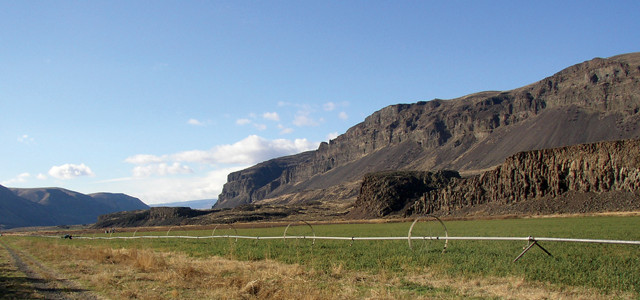
by Adityarup "Rup" Chakravorty Thursday, January 19, 2017

Moses Coulee, amid the Channeled Scablands in Washington state, was carved by floods that burst from massive, naturally dammed glacial lakes during the last ice age. Credit: Williamborg.
Through the early 20th century, geologists argued over how the giant canyons of the Channeled Scablands in Eastern Washington were formed. Ultimately, a theory proposed by J Harlen Bretz in the 1920s — that the canyons were carved by catastrophic, short-lived outbursts of floodwaters unleashed when natural dams holding back glacial lakes collapsed — was shown to be correct. Controversy still exists, though, about the size of these ancient floods.
The “brimful model” commonly proposed by researchers assumes the canyons were completely filled during each cataclysmic event. But in a new study in Nature, researchers suggest that the canyons of the Channeled Scablands could have been carved by a series of smaller floods that reached only partway up the canyon walls.
Isaac Larsen, a geologist at the University of Massachusetts, Amherst, and co-author Michael Lamb of Caltech studied a Channeled Scablands canyon called Moses Coulee. They used hydrodynamic modeling software to simulate a series of floods with incrementally increasing discharges and compared the brimful model to an alternative called the “threshold shear stress model,” which considers the mechanics of how floods of different sizes would have eroded and shaped the landscape.
For example, “if the bedrock is well fractured and jointed, which is the case for the flood basalts in the Channeled Scablands, then individual bedrock blocks can be plucked or eroded from the channel when the shear stresses imparted by the floods on the bed exceed the thresholds for sliding the blocks,” Larsen says.
Moses Coulee is particularly well suited for modeling the effects of ancient floods because the canyon walls have bedrock terraces, which “record the elevation of the channel bed at different stages of canyon carving, enabling us to reconstruct the topography of the canyon going backward in time,” Larsen says.
The researchers found that accounting for erosion of the channel bed by removal of bedrock blocks led to predicted flood discharges that were five to 10 times lower than discharges predicted by assuming the canyon was filled to its brim with water.
Flood discharge estimates in the brimful model reached about 3 million cubic meters per second during the final stages of canyon formation, more than 14 times the average discharge of the Amazon River today. Peak water depth in this model was predicted to exceed 175 meters. In contrast, flood discharge predicted by the shear stress model topped out at about 600,000 cubic meters per second and peak water depth did not exceed 76 meters.
Once the models were run, “we wanted to devise a way to determine which [one] was most consistent with the geological evidence,” Larsen says. So, the researchers examined whether the erosion and deposition patterns created by the hydraulics of the two flood models were compatible with the location of gravel bars within Moses Coulee.
The Great Gravel bar in upper Moses Coulee is a deposit of well-rounded basalt fragments with a median diameter of about 150 centimeters. “The presence and sediment composition of the Great Gravel Bar are consistent with predicted discharges under the shear stress model, but not the brimful model,” says Edwin Baynes, a geoscientist at the University of Rennes 1 in France who was not involved in the study.
The smaller flood volumes predicted by the shear stress model might also solve a puzzling prediction of the brimful model. To fill canyons to their brims as they are progressively eroded and become deeper, each successive flood would have to be larger than the previous one. But “given the source of the floodwater — ice-dam outburst floods — I see no reason why the discharge would be continually increasing,” Baynes says.
According to Larsen and Lamb, if the triggering mechanisms for successive floods were similar, it is likely the floods were of similar volumes and that each one only partially filled canyons like Moses Coulee, which would support the shear stress model.
Understanding how Moses Coulee and other Scablands canyons were sculpted could have interplanetary repercussions, Larsen says. “Our results are consistent with the view that the canyons on Mars formed by floods with discharges that were lower than those predicted by brimful flow.”
That’s important to consider, Baynes says, because estimates of the size of the floods that carved Martian canyons have been presented as evidence for the past presence of large amounts of water — held either in oceans or as groundwater — on the planet. “These new, lower discharge estimates from this study could be consistent with a groundwater source of the floodwaters on Mars.”
© 2008-2021. All rights reserved. Any copying, redistribution or retransmission of any of the contents of this service without the expressed written permission of the American Geosciences Institute is expressly prohibited. Click here for all copyright requests.